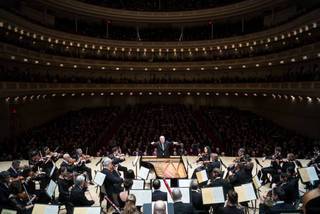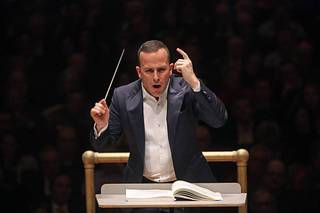|
Back
Brahms Triumphant New York
Isaac Stern Auditorium, Carnegie Hall
11/30/2023 -
Johannes Brahms: Symphonies No. 1 in C minor, Op. 68, & No. 2, Op. 73
Staatskapelle Berlin, Yannick Nézet-Séguin (Conductor)

Staatskapelle Berlin
“My first symphony is long and not altogether very amiable.”
Johannes Brahms
“Whether my second symphony is pretty or not, I don’t know. I will have to ask wiser people.”
Johannes Brahms
It doesn’t take genius to realize that the Berlin Staatskapelle–after half a millennia on the concert stage–better be pretty damned good.
And that is an understatement as evidenced by their first night of the complete Brahms symphonies. This was an orchestra which marched on stage together (no pre‑concerts warmup), showed their full force with every single consort from the opening timpani to the winds to the brass chorale (which could have come from Gabrielli in St. Mark’s Cathedral) to those utterly lustrous strings.
The placement of the strings was somewhat eccentric. Cellos were set within the violin section, double basses just behind the first violins Perhaps this was to achieve an ensemble coloration. But doubtless the Staatskapelle Berlin would, with the right conducting balance, could have achieved the same effect.

Y. Nézet‑Séguin
In this case, the original leader and conductor of the orchestra, Daniel Barenboim, had to be replaced due to illness. So one had to imagine the weighty, serious, almost severe performance by Furtwängler’s acolyte. The replacement, Yannick Nézet‑Séguin, is part of a new generation, though his love for Brahms is frequently expressed. Here the Brahms “weightiness” was present, but the rainbow coloring gave it a patina of personal adoration.
Mr. Nézet‑Séguin started with an electrifying percussion tattoo, for the First Symphony and the poco sostenuto was far greater than poco. Yet such was the tension of this start that–oh, how rare!!–one was left in literal suspense before the main section.
Not, though, the rest of the movement. Mr. Nézet‑Séguin refused to let this become tragic. The violin soared through those springtime themes, winds joined in, and those brass ended with a kind of amen.
Mr. Nézet‑Séguin conducted the second movement with tenderness, leaving us with a relatively ferocious scherzo. The conductor, known for his graceful animated gestures, took the finale in his stride. Brahms’ expressiveness, and that Ninth Symphony chorale was pushed to where the strings, with a thick throbbing tone, led the orchestra to a kind of Mahler‑style passion.
The Second Symphony is of course a gentler work, but Mr. Nézet‑Séguin never let go. One could never call it prickly, but the staccatos (as in the First Symphony) were firmly accented, giving not only an original color but a propulsion driving the music onward.
Onward to the brilliant victorious finale. Brahms didn’t need a Beethoven-style theme to make his point. Each of the Staatskapelle Berlin instruments’ solos were gorgeous, the ensemble offered individual colors, with Mr. Nézet‑Séguin, gesturing with more than drama, but with beckoning and blessing.
Tonght (Friday), Mr. Nézet‑Séguin is finishing the cycle with Symphonies Three and Four. Alas, an important engagement precludes my attendance, so I can only dream about the wonders to be.
Harry Rolnick
|